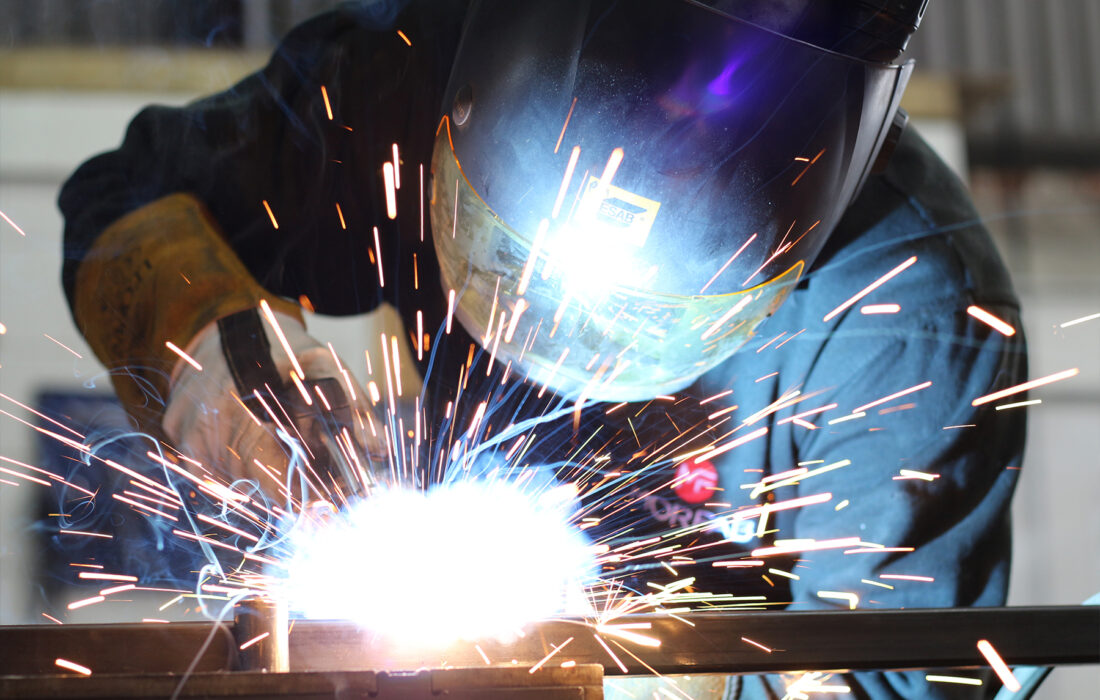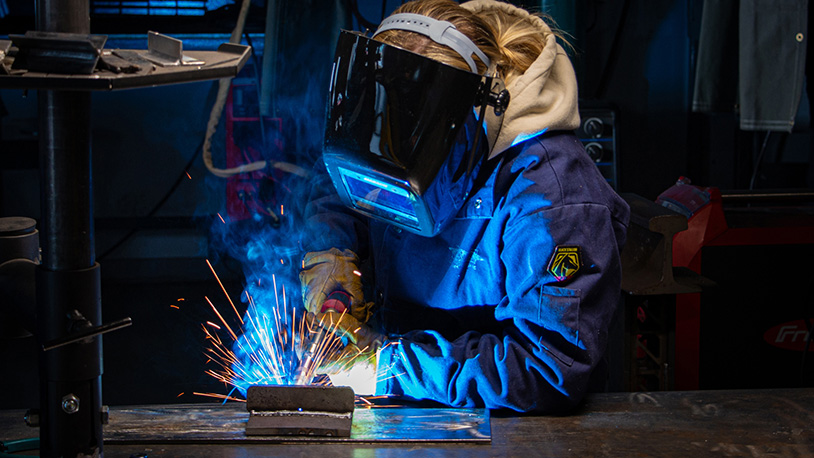All Concerning Welding: Key Insights Into Techniques and Ideal Practices for Success
Welding encompasses a selection of techniques, each suited for details materials and applications. Comprehending these approaches, such as GMAW, SMAW, and TIG, is essential for attaining excellent results. In addition, the best equipment and safety techniques can not be overlooked. As preparation and repairing play important roles in the welding process, understanding these elements can considerably improve the top quality of the final product. What are the vital elements that ensure an effective weld?
Recognizing Different Welding Techniques
Welding strategies encompass a range of methods, each matched to certain applications and products. Amongst one of the most typical methods are Gas Steel Arc Welding (GMAW), Secured Metal Arc Welding (SMAW), and Tungsten Inert Gas Welding (TIG) GMAW, likewise called MIG welding, is preferred for its rate and adaptability, making it optimal for slim products. SMAW, or stick welding, is preferred for its simpleness and efficiency in outside environments, especially with thicker metals. TIG welding offers accuracy and control, making it suitable for complex job and non-ferrous steels (Belgrade Fabrication). Each strategy has its special benefits and considerations, permitting welders to select the very best technique based on the job's needs, material type, and desired end results. Comprehending these strategies is essential for effective welding
Vital Welding Devices and Devices
While numerous welding techniques call for certain skills, the best tools and devices are similarly vital for achieving top quality results. Necessary welding tools includes welding devices, which vary relying on the method-- such as MIG, TIG, or stick welding. Protective equipment, including helmets, aprons, and handwear covers, assurances safety and security and comfort throughout the procedure. In enhancement, components and clamps assist secure materials in area, making sure precision in welds. Consumables like welding rods, cable, and shielding gas are also critical elements that influence the high quality of the weld. In addition, tools such as cutters and mills help with surface prep work and post-weld completing, contributing to a specialist end result. Spending in premium equipment eventually enhances the effectiveness and efficiency of welding projects.
Safety And Security Practices in Welding
Appropriate safety and security techniques are necessary in the welding sector to shield workers from potential risks. Welders must wear proper personal safety equipment (PPE), including helmets with appropriate shading, gloves, and flame-resistant garments. Appropriate air flow is crucial to minimize direct exposure to dangerous fumes and gases created throughout the welding procedure. Additionally, employees must be learnt the appropriate handling of welding devices to stop crashes. Fire safety measures, such as keeping flammable products away from the welding area and having fire extinguishers easily offered, are essential. Normal inspections of equipment and work areas can help identify possible threats before they result in accidents. By sticking to these safety techniques, welders can develop a safer working setting and decrease risks related to their trade.
Preparing Products for Welding
Preparing products for welding is an important step that greatly influences the high quality and stability of the final item (Montana Mobile Welding and Repair Belgrade Welding). Appropriate preparation entails cleaning up the surface areas to eliminate impurities such as dust, oil, and rust, which can compromise the weld. Strategies such as grinding, sanding, or utilizing solvents are commonly employed to accomplish a tidy surface area. In addition, guaranteeing that the products fit together snugly is essential; gaps can lead to weak welds. It's additionally essential to take into consideration the positioning and positioning of the parts, as this will affect the convenience of welding and the last end result. Lastly, selecting the ideal filler material and making certain compatibility with the base metals is essential for achieving solid, sturdy welds
Tips for Achieving High-Quality Welds
Achieving high-grade welds calls for interest to information and adherence to best methods throughout the welding process. Correct joint prep work is important, making certain surface areas are cost-free and clean from pollutants. Selecting the ideal filler product and welding strategy based upon the base steels is critical for optimal bonding. Preserving consistent travel speed and angle while welding can prevent issues and promote harmony. Additionally, managing heat input is crucial; too much heat can lead to bending and deteriorated joints. If needed, on a regular basis examining the welds throughout the procedure permits for immediate adjustments. Lastly, using proper post-weld treatments, such as cleansing and stress alleviation, can improve the sturdiness and integrity of the weld, inevitably making certain an effective end result.
Troubleshooting Common Welding Issues
Welding commonly offers obstacles that can affect the top quality and integrity of the final product. Usual concerns such as check here porosity, inconsistent weld beads, and overheating can arise, each requiring specific troubleshooting techniques. Recognizing these troubles is necessary for welders to enhance their skills and accomplish optimal outcomes.
Porosity Troubles Clarified
Although porosity can typically be overlooked, it remains an important concern in welding that can jeopardize the stability of a completed item. Porosity describes the visibility of tiny gas pockets within the weld bead, which can lead and weaken the joint to premature failure. This issue generally develops from pollutants, moisture, or incorrect securing gas coverage during the welding process. To mitigate porosity, welders need to confirm that the base materials are dry and clean, make use of ideal protecting gases, and keep regular welding specifications. Consistently inspecting the tools and environment can likewise help identify prospective problems before they manifest in the weld. Addressing porosity efficiently is crucial for achieving solid, resilient welds that meet top quality requirements.

Irregular Weld Beans
Irregular weld beads can considerably affect the high quality and strength of a finished item. Numerous variables add to this issue, including incorrect traveling speed, inaccurate amperage setups, and irregular electrode angles. When the welder moves also swiftly, a grain may show up slim and do not have infiltration, while moving also slowly can trigger extreme build-up. In addition, utilizing the wrong amperage can result in either damaging or excessive spatter, both of which compromise weld honesty. The welder's strategy, such as irregular lantern activity, can also cause uneven grain look. To mitigate these troubles, welders need to concentrate on preserving steady, regulated activities and making sure proper tools setups to achieve harmony in their welds. Uniformity is vital to achieving reliable and strong welds.
Getting Too Hot and Warping Issues
Extreme warm during the welding process can result in substantial getting too hot and contorting problems, affecting the architectural stability of the work surface. These issues frequently show up as distortion, which can compromise positioning and fit-up, making more setting up challenging. Factors adding to overheating include the option of welding criteria, such as voltage and travel speed, in addition to the sort of material being welded. To reduce these problems, welders should maintain consistent travel rate and ideal heat input while keeping track of the work surface temperature level. Additionally, pre-heating or post-weld heat treatment can help relieve stresses created by quick cooling - Montana Mobile Welding and Repair Belgrade. Regular inspection and adherence to ideal practices are crucial in preventing overheating and making certain the durability and integrity of welded structures
Frequently Asked Concerns
What Are the Profession Opportunities in the Welding Market?
The welding industry uses diverse career opportunities, consisting of placements as welders, engineers, inspectors, and instructors. Professionals can function in production, building, aerospace, and automobile fields, taking advantage of solid demand and competitive wages in numerous duties.
Just How Can I Improve My Welding Rate Without Compromising Quality?
To improve welding speed without compromising quality, one must exercise effective strategies, maintain tools, maximize settings, and boost hand-eye sychronisation. Regular training and seeking responses can additionally significantly add to achieving faster, premium welds.
What Qualifications Are Readily Available for Welders?
Various certifications exist for welders, consisting of those from the American Welding Culture (AWS), the National Center for Building And Construction Education And Learning and Study (NCCER), and different industry-specific organizations. These credentials improve employability and demonstrate ability effectiveness.
Exactly How Does Welding Impact the Properties of Metals?
Welding influences the buildings of metals by altering their microstructure, which can cause changes in ductility, stamina, and hardness. Warm input and air conditioning rates throughout the procedure significantly affect these material qualities.
Can I Weld Dissimilar Metals Together?
